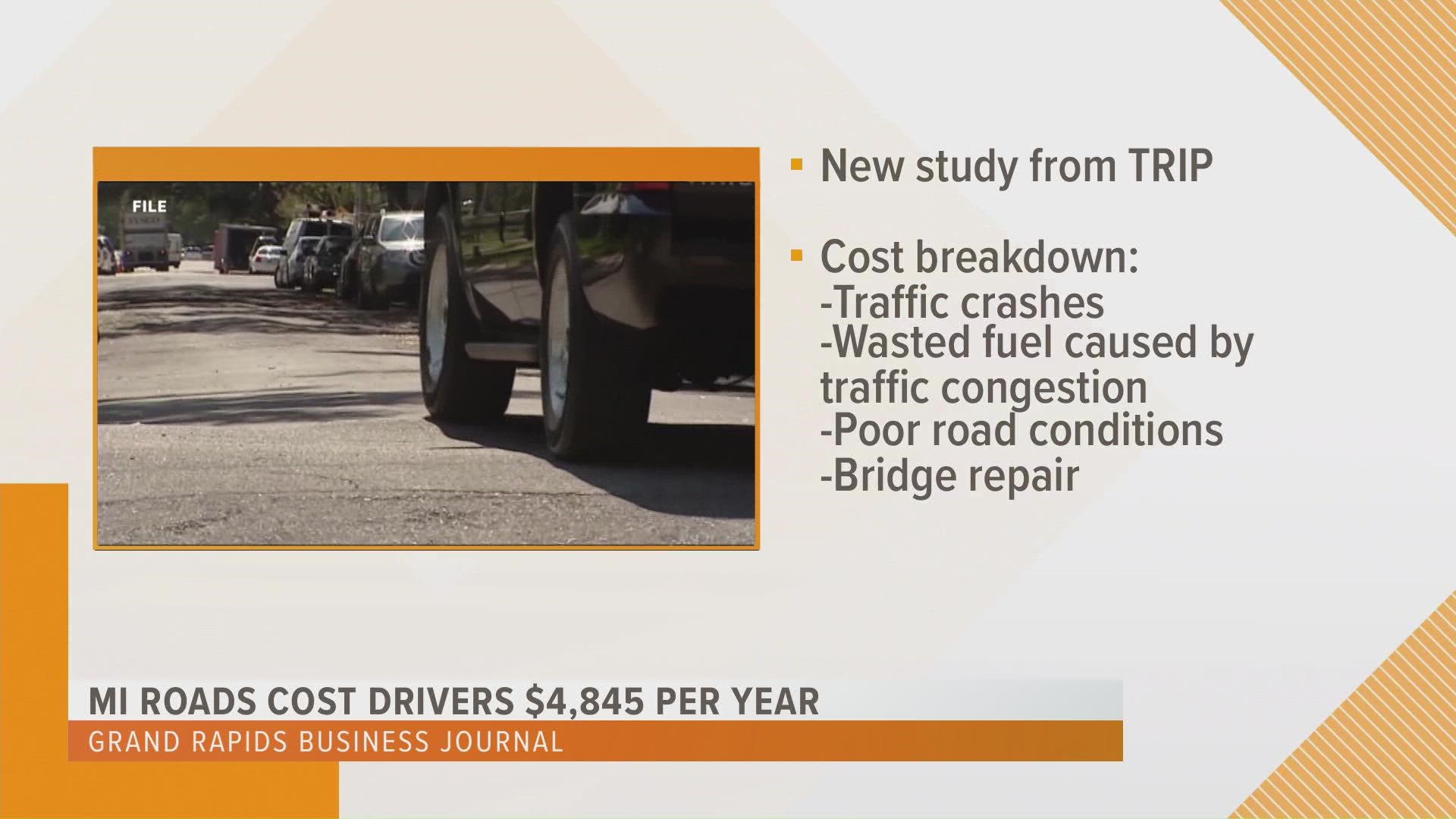GRAND RAPIDS, Mich. — GRBJ—A report from a national transportation research nonprofit indicates Michigan’s current conditions will worsen without significant investment.
TRIP on April 14 released the report “Where Are We Going? Michigan’s Current and Future Pavement and Bridge Conditions, Safety, and Congestion and Reliability Levels” after evaluating the condition and performance of roads, highways and bridges throughout the state.
Currently, the report estimates the state of transportation in Michigan costs the average household $4,845 annually.
These costs come from traffic crashes, wasted fuel from delays caused by traffic congestion and unreliability, extra vehicle operating costs (VOC) due to driving on roads in poor condition and the cost to repair the state’s structurally deficient bridges.
Using data provided by the Michigan Department of Transportation (MDOT), the TRIP report outlines three potential investment scenarios and the impact they would have on the state’s residents and future economic growth.
In the first scenario, Michigan invests in transportation based on current funding formulas, regardless of whether they are necessary to maintain road and bridge conditions as well as traffic congestion. This would increase the average annual cost for households to $6,273.
The second scenario explores Michigan investing at a level necessary to maintain road and bridge conditions as well as traffic congestion levels to prevent them from getting any worse. With this scenario, the annual cost would slightly decrease to $4,694.
In the third scenario, Michigan invests at a level allowing significant improvement in conditions, which would bring the annual cost for Michigan households down to $2,479.
Each of these scenarios is considered within the 2021 to 2031 timeframe.
“It is critically important that adequate investment is made to keep the state’s residents, businesses and visitors moving efficiently and safely,” said Dave Kearby, executive director of TRIP. “Michigan’s economic health and the quality of life of its residents are literally riding on its transportation network.”
In the Grand Rapids area, traffic congestion has worsened in recent years, according to the report. From 2000 to 2019, delays caused by congestion increased 69% from 10 million hours to 17 million hours.
In comparison, while delays in the Detroit area amounted to 160 million hours in 2019, the increase was up only 15% from 2000.
One area of Grand Rapids is within the top 10 of the state’s least reliable highways based on a measure of travel time consistency during the morning and evening peak travel hours. Eastbound I-196 from Fuller Avenue to I-96 ranked No. 6 for morning travel and No. 7 for evening travel.
Other unreliable areas listed were southbound U.S.-131 from Ann Street to I-96 and eastbound I-96 from Leonard Street to M-21 for morning peak travel. For evening peak travel, northbound U.S.-131 from 36th Street to Cherry Street and northbound U.S.-131 from Pearl Street to Leonard Street made the list.
In addition to reducing personal delays caused by traffic congestion, improved traffic flow in Michigan would support economic development by improving the efficiency and competitiveness of Michigan businesses, according to the report.
“Modern, reliable infrastructure is a fundamental building block of a strong economy and Michigan’s competitiveness,” said Wendy Block, vice president of business advocacy and member engagement for the Michigan Chamber of Commerce. “While Michigan has made notable, important strides, it’s imperative that we continue to look for bipartisan, long-term solutions to ensure we are making forward progress.”
One of the ways in which the city of Grand Rapids is seeking to improve its own transportation network is through the Vital Streets Program, which began in 2014.
An overarching goal of the program is to improve road conditions so that 70% of roads are in fair or good condition by 2031. The number was at 37% when the program first launched.
As of April 22, the program page on the city’s website lists 61% as the current progress for this initiative.
The Vital Streets Program also seeks to promote safety, sustainability and diverse transportation options. Projects are backed by a voter-approved plan in 2014 that extended a local income tax levy for 15 years.
This originally appeared in the Grand Rapids Business Journal.
►Make it easy to keep up to date with more stories like this. Download the 13 ON YOUR SIDE app now.
Have a news tip? Email news@13onyourside.com, visit our Facebook page or Twitter. Subscribe to our YouTube channel.

